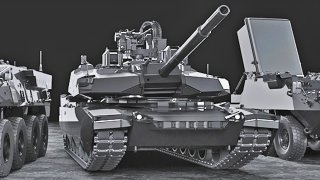5 Best Main Battle Tanks on Earth in 2024
Choosing the best modern tanks is a contentious issue, but five standouts are often regarded as the top contenders. Israel’s Merkava V offers superior protection with its Trophy Active Protection System.
It has vastly increased the tank’s weight, which has been seen as an issue, but the crew’s survivability has also been improved.
The U.S. Army has since canceled a planned SEPv4 upgrade, and will instead direct its efforts towards the M1E3 upgrade, taking the best features of the v4 while introducing a modular open-systems architecture standard to allow for faster and more efficient technology upgrades of the MBT. Until those new versions arrive, the SEPv3 models continue to be produced.
South Korea’s K2 Black Panther
Yes, the list doesn’t include the German Leopard 2 or British Challenger 2—both of which are exceptional tanks. Instead, the final spot goes to the South Korean K2 Black Panther.
Even a decade ago it would have been unimaginable to think that South Korea could produce such a capable tank, and yet, it might be the best in service in the world today. During the Korean War, the first tanks deployed by the United Nations forces were the American M24 Chaffee light tanks. Not unexpectedly the M24s fared poorly against North Korea’s Soviet-built T-35-85s. Following the war, the South Korean military bolstered its armored fleet with a variety of U.S.-made tanks, but attempts made to obtain the M60A1 Patton MBTs in the 1970s ended in failure.
Always fearing that its neighbor to the north would launch an attack across the demilitarized zone, South Korea took matters into its own hands and developed a domestically produced tank—the K1, which was based on the early designs of the American XM1 program that led to the development of the M1 Abrams.
Seoul has since moved forward with an entirely new design: the K2 Black Panther, a next-generation MBT developed by the South Korean Agency for Defense Development and manufactured by Hyundai Rotem. The K2 was meant to complement—rather than replace—the K1 series MBTs that are currently fielded by the South Korean military.
The K2 was developed utilizing indigenous technology only, and the first prototype was unveiled in 2007, while production commenced for the first 100 K2 tanks in 2014. It is considered one of the most advanced MBTs in the world, outclassing any tanks in service with North Korea or even China.
As Harrison Kass previously reported for The National Interest, ”Each unit thus represents a significant investment in South Korean defense capabilities. Hyundai, better known for its mid-to-low-priced cars, manufactures the K2. But the K2 is no Hyundai Santa Fe. This is a serious, cutting-edge piece of technology—the world’s first and only fourth-generation battle tank.”
It was in June 2023 that Seoul approved the production of another run of K2 Black Panthers in a deal worth an estimated 1.94 trillion won ($1.46 billion). It was the fourth round of mass production of the MBT, TheDefensePost reported.
The K2 Black Panther MBT has a crew of three members including a commander, gunner, and driver. The MBT’s main armament is a Rheinmetall 120mm L/55 smoothbore gun, produced under license in South Korea and equipped with a domestically-designed automatic loader—which can ensure the loading of projectiles on the move, including when on uneven surfaces. The 120mm gun can reportedly fire approximately ten to fifteen rounds per minute. It can be used with a variety of munitions and is compatible with all standard NATO tank rounds. The 120mm L/55 gun is also capable of firing the new KSTAM (Korean Smart Top-Attack Munition) rounds—smart target-activated fire-and-forget projectiles.
The secondary armament of the Black Panther includes a 12.7mm heavy machine gun and a 7.62mm machine gun.
South Korea’s next-generation tank is equipped with a domestically-developed auto target detection and tracking system, which incorporates a hunter-killer function. The tank also features an electric gun and turret driving system (28-260VDC) provided by Doosan Corporation Mottrol. In addition, the gunner’s primary sight (GPS) and commander’s panoramic sight (CPS) are stabilized in two axes and include a thermal imager and laser rangefinder enabling day/night observation.
Though not as speedy as its namesake, the Black Panther can still hunt down its slower-moving prey thanks to its license-built MTU MB 883 Ka501 diesel engine, which produces 1,500 horsepower. It can reach a top speed of 43 mph on the road, and 31 mph cross country. There is also an auxiliary gas turbine power unit, offering 400 horsepower.
The tank also is equipped with a unique suspension system, which can be contorted into a variety of positions. For cross-country performance, the suspension is raised, providing the K2 greater ground clearance, while on roads, the suspension is lowered, hugging the ground for better speed. In addition, the K2 can “lean,” “sit,” or “kneel” to provide the main gun better maneuverability in hull-down positions. When leaning backward, the K2 can raise its main gun to target low-flying aircraft or to better target more highly elevated targets on the Korean Peninsula’s hilly terrain. The K2 can even lean to the left or the right, which improves maneuverability when driving along slopes.
The capabilities of the K2 Black Panther have been noted in Europe, and Poland has been among the NATO member states to adopt the MBT—and by all accounts, it won’t be the last.
Author Experience and Expertise: Peter Suciu
Peter Suciu is a Michigan-based writer. He has contributed to more than four dozen magazines, newspapers, and websites with over 3,200 published pieces over a twenty-year career in journalism. He regularly writes about military hardware, firearms history, cybersecurity, politics, and international affairs. Peter is also a Contributing Writer for Forbes and Clearance Jobs. You can follow him on Twitter: @PeterSuciu. You can email the author: [email protected].
All images are Creative Commons and/or Shutterstock.


